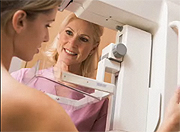
TUESDAY, April 1, 2014 (HealthDay News) — The benefits of mammography screening are probably oversold, while the risks — especially “overdiagnosis” — are underappreciated, a new review concludes.
The report, published in the April 2 issue of the Journal of the American Medical Association, adds to the controversy that’s been building in recent years over the value of mammography screening. In this latest finding, data from 50 years of research was analyzed.
In 2009, the U.S. Preventive Services Task Force (USPSTF) caused a stir when it changed its recommendations on mammograms, which had long advised women to have one every one to two years, starting at age 40.
The revised guidelines now say routine screening should begin at age 50, and be done every two years. If a woman wants to begin screening in her 40s, the task force suggests she discuss the pros and cons with her doctor.
The changes came in response to growing evidence that for women in their 40s, there is only a small “net benefit” from mammography screening. And the new findings show more of the same.
Researchers found that, based on clinical trials done since the 1960s, mammograms can save lives, but the effects are small for women in their 40s: Screening cuts the risk of death from breast cancer by an average of 15 percent in this age group.
And that small benefit has to be weighed against the risks of screening, said review co-author Dr. Nancy Keating.
The risk that concerns Keating the most is “overdiagnosis” — where women with tumors that would never have threatened their lives go through needless surgery, chemotherapy and radiation.
Experts now know that some breast cancers never progress to the point where a lump would be felt, or even go away on their own. But with screening, those cancers are detected and treated.
“We have no way of knowing which patients will progress,” said Keating, of Harvard Medical School and Brigham & Women’s Hospital in Boston. “So we have to treat everyone we diagnose.”
It’s hard to estimate the number of women who are overdiagnosed with breast cancer, Keating said. But based on the studies her team reviewed, a “best estimate” is that 19 percent of cancers diagnosed over 10 years of screening are actually overdiagnoses.
“We think mammography has a benefit,” Keating said, “but it’s smaller than many people believe. And the risk of overdiagnosis, in particular, has not received a lot of attention.”
Older women, who have a higher rate of breast cancer, see more benefits from screening, the review found: For those in their 60s, mammograms reduce the risk of breast cancer death by one-third.
One cancer expert said the estimates sound about right.
“Mammography does appear to save lives, but it’s not as effective as people have thought,” said Dr. Otis Brawley, chief medical officer for the American Cancer Society.
Unlike the USPSTF, the American Cancer Society still suggests that women start yearly mammograms at age 40.
But, Brawley said, “there’s a second line to the recommendation that doesn’t get quoted in the media.”
The “second line” says doctors should also tell women about the limitations and potential harms of screening, so they can make an informed decision.
“I’ve long been worried that we’re overselling the benefits of mammography,” Brawley said. He stressed, though, that “even though the benefit is less than promised, there’s still a benefit.”
Brawley also noted that 20 years ago, mammography might have had a bigger impact. Breast cancer treatment has improved so much that earlier detection through screening may not make as much of a difference as it did two decades ago, he explained.
Meanwhile, the American College of Radiology and the Society of Breast Imaging issued a joint statement Tuesday that questioned the validity of some of the data that was used in the Harvard review, and both groups reiterated their support of the value of annual mammograms for women aged 40 and older.
And the president and CEO of Susan G. Komen had this to say about the latest finding:
“We know mammography’s shortcomings. We’re very concerned about the potential for overdiagnosis and overtreatment,” Judith Salerno said in a statement issued Tuesday. “But it’s the most widely available test that we have for now.
“UItimately, we need more accurate screening tools. Komen is investing in research to develop those,” Salerno added. “But until those tools are widely available, our position is that a woman should have access to a mammogram if she and her doctor think she should have one.”
Where does this leave women?
“There’s no one-size-fits-all here,” Keating said, adding that screening decisions require a “more nuanced discussion.”
Giving women some numbers can help, according to Keating. For example, the average 40-year-old American woman has a 1.5 percent chance of developing breast cancer over the next 10 years. If she has a mammogram in each of those years, her risk of a false-positive result is 61 percent, Keating’s team estimates.
False-positive results lead to needless follow-up tests and, for some women, anxiety.
On the other hand, Keating noted, many women are not put off by the possibility of a false-positive and would rather have the test.
“I tell my patients it’s important to understand that mammography isn’t perfect,” Keating said. “It has limitations. It misses some cancers, and some women will die of breast cancer even if they have a mammogram,” she explained.
“Some patients say, OK, I’ll delay or have them less often,” Keating said. “Some decide they still want to have one every year.”
In the same issue of the journal, a second review found that life expectancy should be the biggest factor when it comes to whether women aged 75 and older should get screening mammograms. Unless the woman is expected to live for at least another decade, the harms outweigh the benefits, the researchers from the University of California, San Francisco, and Harvard Medical School concluded.
More information
The U.S. National Cancer Institute has more on breast cancer screening.
Copyright © 2026 HealthDay. All rights reserved.

